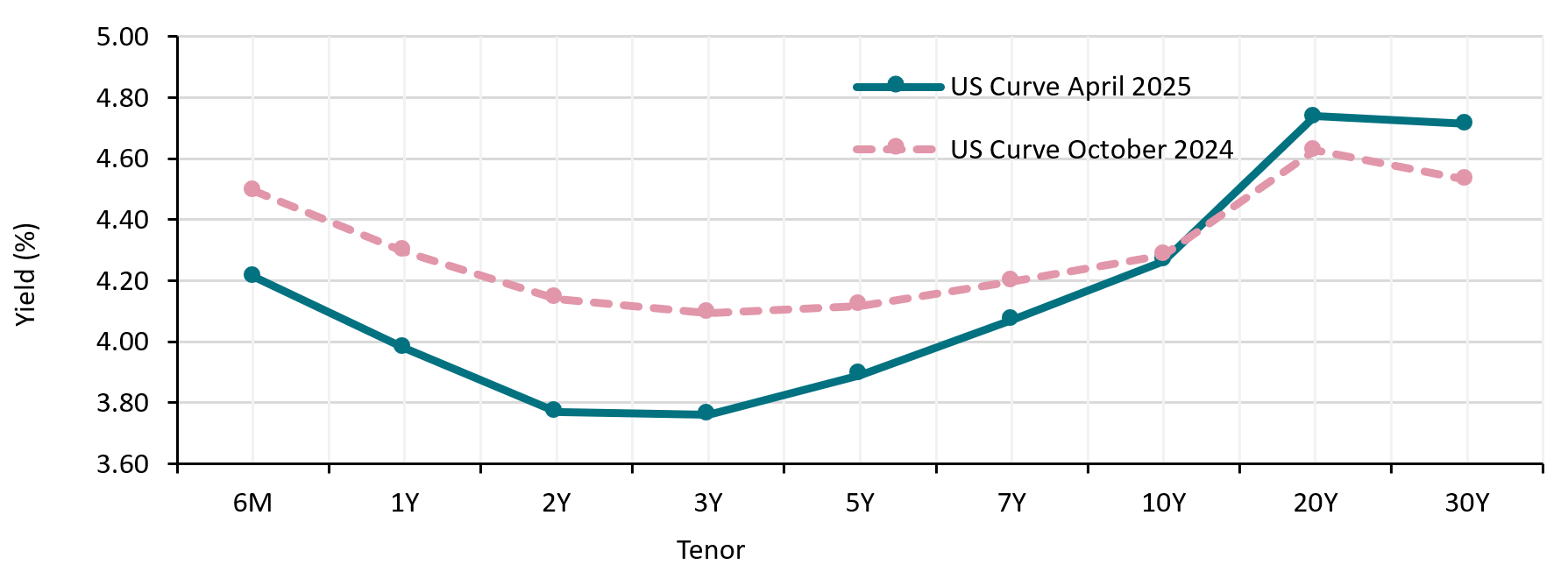
Harnessing the power of duration in global bond portfolios
KEY POINTS
Following the rise of global interest rates on the back of much higher inflation over the last few years, investors are now focusing on the expectation for lower official rates, as the tightening of financial conditions has spurred central banks to start loosening monetary policy.
Such a backdrop typically delivers a positive boost for bond returns, but we are finding the path to lower interest rates and lower bond yields is not that simple. As active top-down managers of global portfolios, we believe the power of duration and its impact on total returns should not be overlooked.
Managing duration is not just a question of owning duration or not; in a global context, there are different yield curves to be exposed to. It's possible to build meaningful duration exposure even when focusing on shorter-maturity bonds.. So, we think about overall duration exposure, the geographic curves that we have exposure to, and finally which maturity part of that curve is likely to be the most impactful.
Different bond curves
Bond market yields reflect evolving expectations of global interest rates. In recent cycles, especially in a world of quantitative easing-manipulated yield curves, expectations surrounding global interest rates generally converged around the U.S. However, diverging fiscal policies and countries being at different points in their economic cycle means there are differences in the approaches of major central banks and, consequently, dispersion in both the direction and level of core government bond yields.
As top-down managers, this dispersion brings the opportunity to actively manage duration exposure across countries by taking exposures to different interest rate curves to reflect the varied growth and inflation prospects across the global economy.
Looking back over previous quarters, the chart below shows how the German and U.S. bond yields, while often moving in the same direction can outperform or underperform each other. Typically, this is driven by a combination of factors, but we believe economic fundamentals and differing central bank polices play an important role.
In addition, bond market sentiment alongside supply and demand dynamics evolve and reflect differing outlooks. The relative movement across different curves can therefore create opportunities to enhance returns. We believe this combination of diversification across different yield curves, alongside active fund management should enable investors to benefit from government bond markets.
Different maturities along the yield curve
In the same way that different yield curves evolve, the shape of the yield curve is in constant flux. As all-maturity bond investors, it is our job to analyze these changes and adjust portfolios to gain exposure to the parts of the curve that represent attractive opportunities and compliment the rest of the strategy.
In our view, the current market trend is for bond curves to “steepen” which means that shorter maturities are outperforming longer-dated maturities on the expectation that interest rates should get cut. Being the bond market however, there are various, sometimes complex ways that this can manifest itself. A bullish steepening is where all yields move lower but short-dated outperform their long-dated equivalent. A bearish steepening will see the same outperformance but where all yields rise. It is also possible that short-dated bonds can move lower and longer-dated bonds can move higher.
A common misconception is that to build a bullish duration position, investors need to own longer-dated bonds. To build the same outright duration risk but at the short end of the curve, we believe investors simply need to be exposed to more short-dated bonds.
To bring this to life, we can look at the steepening of the U.S. Treasury yield curve over the last six months. The steepening has been driven by both falling front-end yields and rising long-end yields. As we see it, hoad a long duration position been built by exposure at the long end, the duration risk factor of the portfolio would have been a drag on returns; however, a long duration position through shorter-dated bonds would have boosted performance.
US Treasury Yield Curve

Change in Yield

Source: AXA IM and Bloomberg as of 28th April 2025
If you stop to look around, you just might miss it
Markets are moving quickly. Uncertainty around tariffs and their potential impact on inflation; rapid geopolitical developments; fiscal policy shifts; and a less than clear path for central banks all seems to be driving a period of rates volatility. Therefore, by harnessing the return power of duration, we believe investors could potentially benefit from both diverse and actively-managed duration exposure in bond portfolios.
We are constantly monitoring the macroeconomic environment to determine tactical duration positioning. In our global bond portfolios, cash bonds are an important source of duration risk, but
using futures to manage duration risk provides even more flexibility. We describe the use of futures as our duration overlay, allowing portfolio managers to rapidly and dynamically implement duration views in anticipation of market events, or as they unfold. To reflect these views, we buy or sell government bond futures in a specific currency and maturity. By taking this approach we seek to add, cut, neutralize, or tweak our duration exposure and target these views across regions or maturities, or both.
In conclusion, we’re in a new era marked by higher rates volatility and wider dispersion in yields across core government bond markets. This environment offers more opportunities for managers who can adopt a dynamic, flexible, and tactical approach to duration risk, thereby unlocking the true potential of one of fixed income's major performance drivers.
Disclaimer
Risk Warning
Investment involves risk including the loss of capital.
The information has been established on the basis of data, projections, forecasts, anticipations and hypothesis which are subjective. This analysis and conclusions are the expression of an opinion, based on available data at a specific date. Due to the subjective aspect of these analyses, the effective evolution of the economic variables and values of the financial markets could be significantly different for the projections, forecast, anticipations and hypothesis which are communicated in this material.
Disclaimer
This document is being provided for informational purposes only. The information contained herein is confidential and is intended solely for the person to which it has been delivered. It may not be reproduced or transmitted, in whole or in part, by any means, to third parties without the prior consent of the AXA Investment Managers US, Inc. (the “Adviser”). This communication does not constitute on the part of AXA Investment Managers a solicitation or investment, legal or tax advice. Due to its simplification, this document is partial and opinions, estimates and forecasts herein are subjective and subject to change without notice. There is no guarantee forecasts made will come to pass. Data, figures, declarations, analysis, predictions and other information in this document is provided based on our state of knowledge at the time of creation of this document. Whilst every care is taken, no representation or warranty (including liability towards third parties), express or implied, is made as to the accuracy, reliability or completeness of the information contained herein. Reliance upon information in this material is at the sole discretion of the recipient. This material does not contain sufficient information to support an investment decision.
© 2025 AXA Investment Managers. All rights reserved.





